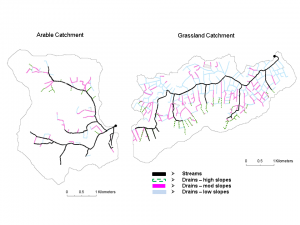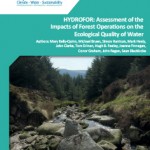The EPA has published the results of the HYDROFOR research…
A smart approach to managing open drains protects water quality
Phosphorus is an essential nutrient for crop production, but is easily mobilised to surface waters from heavy soils during rainfall and can negatively impact water-quality.
To maintain Ireland’s trend of improving water- quality, solutions that mitigate phosphorus transfers after mobilisation will be needed. These solutions need be economically viable and thus not place undue burden on the area of land required for production. Runoff attenuating features, such as buffer strips, ponds and wetlands, are commonly used to mitigate phosphorus transfers, however their utility is limited by small sizes in larger catchments and so a targeted approach is needed to locate them appropriately.
Phosphorus loss to streams tends to be highest on farms with heavy soils and these farms are likely to have many open drains. Open drains can be considered as networks of linear runoff attenuation features but unlike buffer strips, ponds and wetlands, they do not occur on productive land and occupy larger areas. Small changes to the management of these drains could help farmers achieve production goals without impacting on water-quality.
Recently, the Teagasc Agricultural Catchments Programme characterised the open drains and stream channels in two contrasting catchments (both ca. 12km2) in County Wexford; a well-drained arable catchment and a poorly-drained grassland catchment. The Agricultural Catchments Programme study found that these channels occupied 50,000m2 (0.45% of the catchment area) in the arable catchment and 150,000 m2 (1.25% of the catchment) in the poorly-drained grassland catchment. Laboratory tests showed that the sediments in the open drains had potential to trap phosphorus that had been washed off the land. That is to say the sediments could draw phosphorus out of the overlying water and lock it up. This process reduces the chances of the phosphorus moving into downstream rivers or lakes where it could cause environmental damage. Sediment itself can also directly damage rivers and lakes so any management practices that retain sediments in drain networks and returns it safely to the land would have the dual benefit of reducing both sediment and phosphorus losses downstream. For example, widening the drain would slow down the flow and encourage more sediment and phosphorus retention. This could, therefore, be considered as a management tool in particularly risky areas.

The study found that flat drains (i.e. blue drains in Figure 1) had the greatest potential to retain sediment and are therefore valuable landscape features. However, over time these flat ditches can get clogged up with sediment and the sediment can become saturated with phosphorus. Once a critical level of phosphorus saturation is reached, the sediment could release the phosphorus back into the drainage water. Regularly cleaning out ditches would ensure that this critical level of saturation is never reached. The sediment that is removed should be kept on the farm where it can be spread on a dry area away from drains to add to soil fertility and prevent it getting back into drains. To protect fish eggs and small salmonids, maintenance of drains likely to contain these species should be carried out between mid-May and mid-September.
Drains with slopes greater than 2% (i.e. pink and green drains in Figure 1) were more vulnerable to sediment and phosphorus being mobilised and washed downstream during rain storms. Encouraging vegetation growth on the drain beds would help to stabilise the sediment and reduce the potential for movement during
storms. The ACP has also found that streams (i.e. black channels in Figure 1) don’t tend to retain much sediment due to the faster flow of water through them. However, the faster flow rates can erode a lot of the bank sediment, causing water-quality problems downstream. Planting and maintaining hedgerows alongside channels could stabilise these banks and reduce this erosion.
To ensure productivity growth under FoodWise 2025 plans, better use of existing nutrients will be required overall. The smart approach to drain management suggested here will always work best in tandem with good soil nutrient management planning to ensure maximum crop availability and minimum losses in runoff and leaching.







